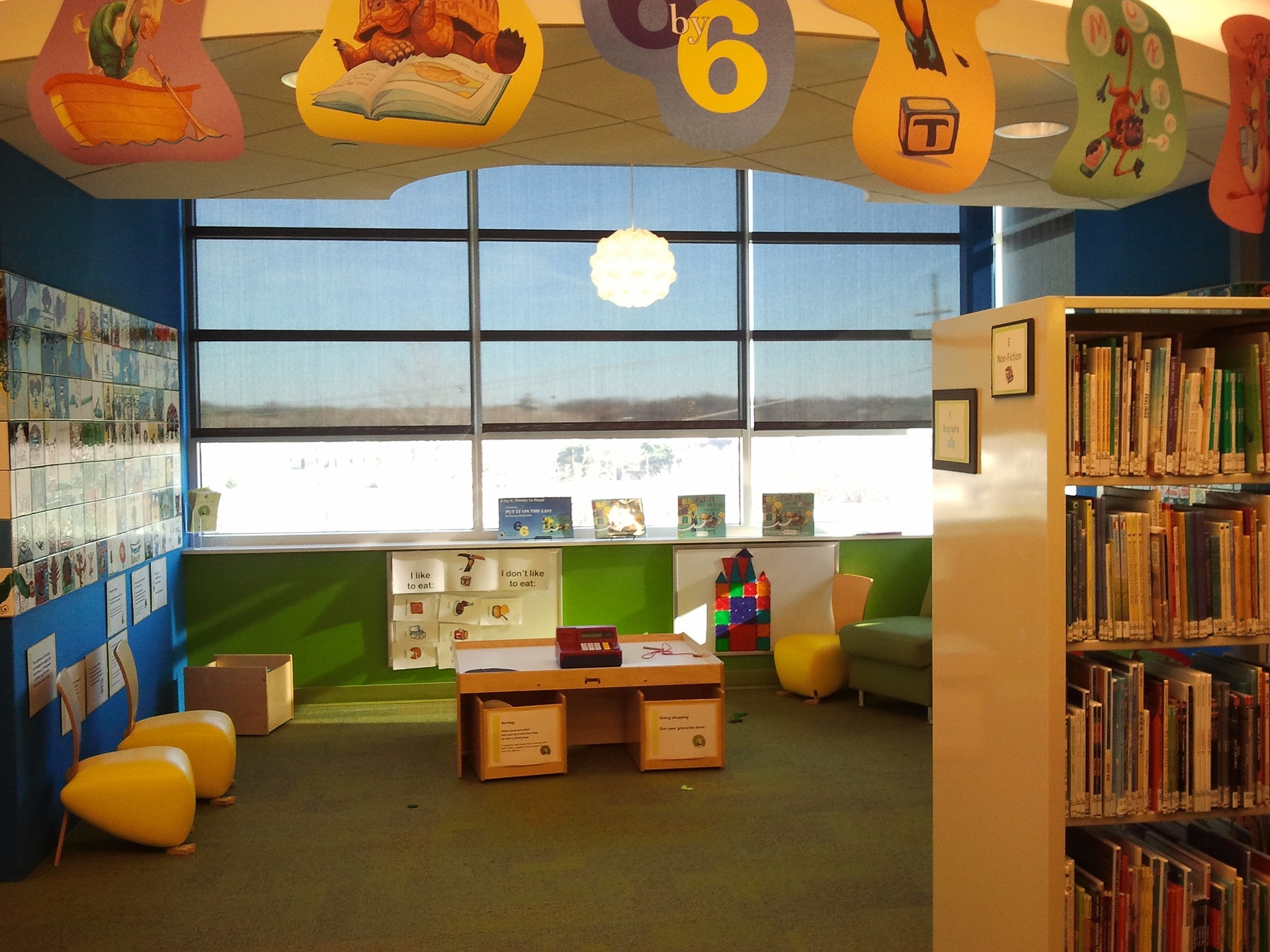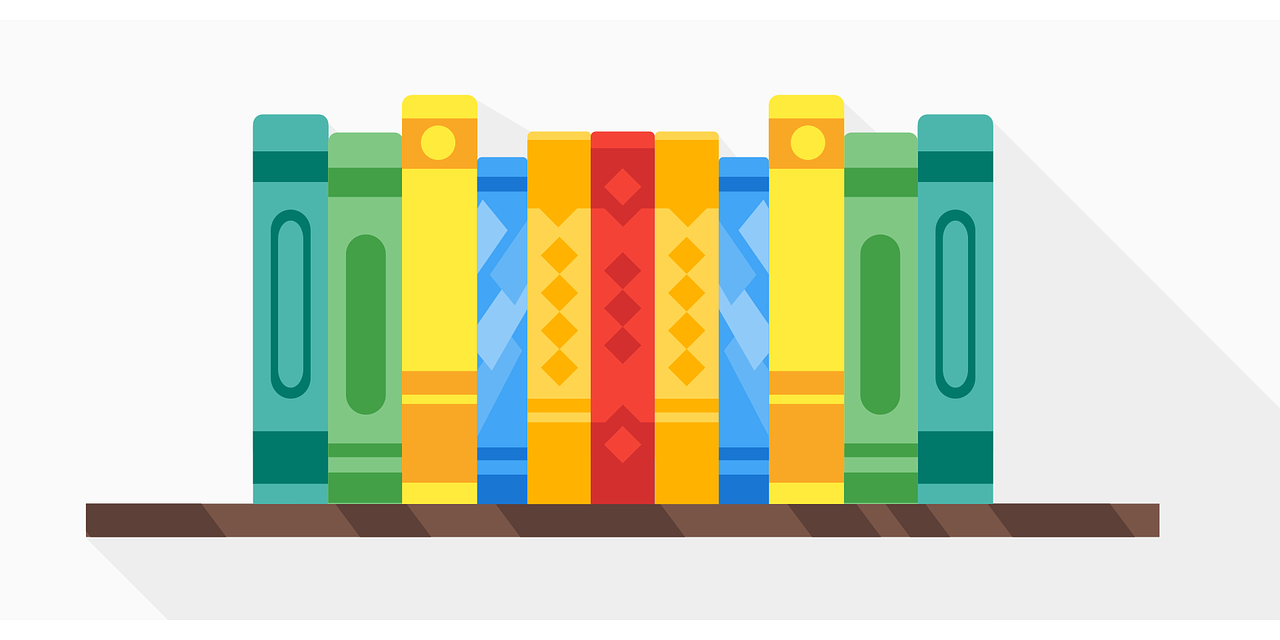Lesson 1
Story Problems and Expressions
Warm-up: Notice and Wonder: A Library (10 minutes)
Narrative
The purpose of this warm-up is to elicit the idea that math is found everywhere in our world. Students look for mathematical situations in a picture of a library, which will be helpful when students solve story problems about the library in later activities. While students may notice and wonder many things about this image, noticing numbers or quantities in the image are the important discussion points.
Launch
- Groups of 2
- Display the image.
- “What do you notice? What do you wonder?”
- 1 minute: quiet think time
Activity
- “Discuss your thinking with your partner.”
- 1 minute: partner discussion
- Share and record responses.
Student Facing
What do you notice?
What do you wonder?

Student Response
For access, consult one of our IM Certified Partners.
Activity Synthesis
- “Tell a math story based on the picture.” (There were two books on the shelf. Then the librarian put two more books on the shelf. How many books are on the shelf now? There are six pictures hanging from the ceiling. Three pictures fall down. How many pictures are still hanging from the ceiling?)
Activity 1: The Library (20 minutes)
Narrative
The purpose of this activity is for students to make sense of the structure of a Take From, Result Unknown story problem. Students have access to connecting cubes or two-color counters and 10-frames, which they may choose to use strategically to represent and solve the problem (MP5). Some students may apply the ideas from the previous unit where they related subtraction to counting back. As students share their methods, the teacher records their thinking. It is important for the teacher to focus attention on the expression during the activity synthesis. Although some students may attempt to write equations and do so accurately, this representation will be the focus in a later lesson.
Students keep their books closed for the launch of the activity, as the teacher displays and reads the problem.
Advances: Speaking, Conversing
Required Materials
Materials to Gather
Launch
- Groups of 2
- Give students access to 10-frames and connecting cubes or two-color counters.
- Display the image from the warm-up.
- “This is a picture of a library. Talk to your partner about what you know and what you wonder about libraries.”
- 3 minutes: partner discussion
- Share and record what students know and wonder about libraries.
- "We are going to solve a lot of story problems about libraries."
- Display and read the numberless story.
- 30 seconds: quiet think time
- 1 minute: partner discussion
- Share responses.
- If not already mentioned, ask, “Are there more or fewer kids at the library after some go home?”
Activity
- Ask students to open their books.
- Read the problem with numbers.
- 2 minutes: independent work time
- “Share your thinking with your partner.”
- 2 minutes: partner discussion
- Monitor for students who solve or represent the problem in the following ways:
- objects
- drawings
- count back
- an expression (\(9 - 2\))
Student Facing
-
Some kids were at the library.
Then some of the kids went home.
What do you notice?
What do you wonder?
-
There were 9 kids at the library.
Then 2 of the kids went home.
How many kids are at the library now?
Show your thinking using drawings, numbers, or words.
Student Response
For access, consult one of our IM Certified Partners.
Advancing Student Thinking
- “How did you choose how many connecting cubes to take out?”
- “There are nine kids at the library. Which connecting cubes show the nine kids? Which connecting cubes show the two kids that went home?”
Activity Synthesis
- Invite previously identified students to share in the order listed above.
- “How are these representations the same? How are they different?”
- If needed, display \(9 - 2\).
- “How does this expression match the story problem?”
Activity 2: Story Problems about the Library (20 minutes)
Narrative
The purpose of this activity is for students to solve Add To and Take From, Result Unknown problems in a way that makes sense to them (MP1). The problems use the same numbers in order to encourage students to think about the action in the problem and how it relates to operations. Students may represent the problems with objects or drawings, and count all, count on, or count back to solve the problems. Students write expressions and some may attempt to write equations.
During the lesson synthesis, students are re-introduced to equations. They notice how the answer to the question is represented in the equation. The teacher draws a box around the answer to signify that this part of the equation is the answer to the question.
Supports accessibility for: Conceptual Processing, Organization
Required Materials
Materials to Gather
Launch
- Groups of 2
- Give students access to 10-frames and connecting cubes or counters.
Activity
- Read the story problems.
- 6 minutes: independent work time
- “Share your thinking with your partner. Be sure that you both agree on the answer.”
- 4 minutes: partner discussion
Student Facing
-
5 books were on a shelf.
Clare put 2 more books on the shelf.
How many books are on the shelf now?
Show your thinking using drawings, numbers, or words.Expression: ________________________________
- 6 books were stacked up on the table.
4 of the books fell on the floor.
How many books are still on the table?Show your thinking using drawings, numbers, or words.
Expression: ________________________________

-
6 kids were listening to a story.
4 more kids joined the group.
How many kids are listening to the story now?
Show your thinking using drawings, numbers, or words.Expression: ________________________________
- There were 5 computers turned on. The librarian turned 2 of the computers off.
How many computers are still on?
Show your thinking using drawings, numbers, or words.Expression: ________________________________
Student Response
For access, consult one of our IM Certified Partners.
Activity Synthesis
- Review solutions and expressions for both story problems with the numbers 5 and 2.
- “How does the expression match the story?”
- If needed ask, "What does the 5 represent? What does the 2 represent?”
- “How are these problems the same? How are they different?” (They have the same numbers, but different answers. Problem 1 is addition, problem 4 is subtraction.)
Lesson Synthesis
Lesson Synthesis
Display the problem about books on a shelf.
“Today we wrote expressions to represent story problems. For this problem we wrote the expression 5 + 2. Then we solved the problem. We can write an equation that shows the answer. The equation “\(5 + 2 = 7\)” tells us that 5 plus 2 is the same amount as 7.”
“What does the 7 represent?” (the total number of books on the shelf, 5 books + 2 books)
“When we write an equation, we can draw a box around the number that shows the answer to the question. That means the equation would be written as \(5 + 2 = \boxed{7}\).“
Cool-down: Unit 2, Section A Checkpoint (0 minutes)
Cool-Down
For access, consult one of our IM Certified Partners.